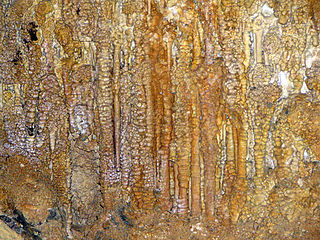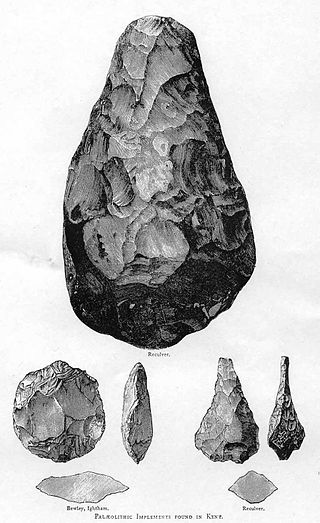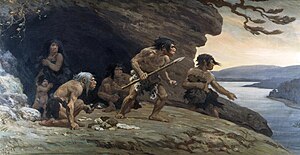
The Paleolithic or Palaeolithic, also called the Old Stone Age, is a period in human prehistory that is distinguished by the original development of stone tools, and which represents almost the entire period of human prehistoric technology. It extends from the earliest known use of stone tools by hominins, c. 3.3 million years ago, to the end of the Pleistocene, c. 11,650 cal BP.

The Stone Age was a broad prehistoric period during which stone was widely used to make stone tools with an edge, a point, or a percussion surface. The period lasted for roughly 3.4 million years and ended between 4,000 BC and 2,000 BC, with the advent of metalworking. It therefore represents nearly 99.3% of human history. Though some simple metalworking of malleable metals, particularly the use of gold and copper for purposes of ornamentation, was known in the Stone Age, it is the melting and smelting of copper that marks the end of the Stone Age. In Western Asia, this occurred by about 3,000 BC, when bronze became widespread. The term Bronze Age is used to describe the period that followed the Stone Age, as well as to describe cultures that had developed techniques and technologies for working copper alloys into tools, supplanting stone in many uses.

The Cave of Altamira is a cave complex, located near the historic town of Santillana del Mar in Cantabria, Spain. It is renowned for prehistoric cave art featuring charcoal drawings and polychrome paintings of contemporary local fauna and human hands. The earliest paintings were applied during the Upper Paleolithic, around 36,000 years ago. The site was discovered in 1868 by Modesto Cubillas and subsequently studied by Marcelino Sanz de Sautuola.

Les Eyzies-de-Tayac-Sireuil is a former commune in the Dordogne department in Nouvelle-Aquitaine in southwestern France. On 1 January 2019, it was merged into the new commune Les Eyzies.

The Upper Paleolithic is the third and last subdivision of the Paleolithic or Old Stone Age. Very broadly, it dates to between 50,000 and 12,000 years ago, according to some theories coinciding with the appearance of behavioral modernity in early modern humans, until the advent of the Neolithic Revolution and agriculture.

Walking with Cavemen is a 2003 four-part nature documentary television miniseries produced by the BBC Science Unit, the Discovery Channel and ProSieben. Walking with Cavemen explores human evolution, showcasing various extinct hominin species and their inferred behaviours and social dynamics. The original British version of the series is presented by the British researcher Robert Winston; in the American version Winston's appearances and narration is replaced with narration by Alec Baldwin.

Betty Rubble is a fictional character in the television animated series The Flintstones and its spin-offs and live-action motion pictures. She is the black-haired wife of caveman Barney Rubble and the adoptive mother of Bamm-Bamm Rubble. Her best friend is her next-door neighbor Wilma Flintstone.

Chuck Rock is a 1991 slapstick side-scrolling platform video game developed and published by Core Design for the Atari ST and Amiga computers. A Commodore 64 port followed in 1992 and an Amiga CD32 version in 1994. The game was subsequently published by Krisalis Software for the Acorn Archimedes. Virgin Interactive published the game for the Sega Mega Drive/Genesis, Master System, and the Game Gear. Sony Imagesoft published the game for the Sega Mega-CD, Super NES, and Game Boy.
Neanderthals have been depicted in popular culture since the early 20th century. Early depictions conveyed and perpetuated notions of proverbially crude, low-browed cavemen; since the latter part of the 20th century, some depictions have modeled more sympathetic reconstructions of the genus Homo in the Middle Paleolithic era. In popular idiom, people sometimes use the word "Neanderthal" as an insult - to suggest that a person so designated combines a deficiency in intelligence and a tendency to use brute force. The term may also imply that a person is old-fashioned or attached to outdated ideas, much in the same way as the terms "dinosaur" or "Yahoo".
A caveman is a popular stylized characterization of how early humans or hominids looked and behaved. A cave dweller is a real human being who lives in a cave or under a cliff.
The GEICO Cavemen are trademarked characters of the auto insurance company GEICO, used in a series of television advertisements that aired beginning in 2004. The campaign was created by Joe Lawson and Noel Ritter while working at The Martin Agency. According to an episode of the public radio show 99% Invisible, "It's so easy a caveman could do it" was first coined by Ritter. The inspiration for the campaign came from "Pastoralia", a short story by George Saunders, which revolves around a man and a woman, who work as "cave-people" for a failing theme park. In 2004, GEICO began an advertising campaign featuring Neanderthal-like cavemen in a modern setting. The premise of the commercials is that using GEICO's website is "so easy, a caveman could do it"; and that this slogan offends several cavemen, who not only still exist in modern society but live as intelligent, urbane bachelors. The first three GEICO commercials to feature cavemen were "Apartment", "Apology", and "Boom Mic".

Paleolithic religions are a set of spiritual beliefs and practices that are theorized to have appeared during the Paleolithic time period. Paleoanthropologists Andre Leroi-Gourhan and Annette Michelson believe unmistakably religious behavior emerged by the Upper Paleolithic, before 30,000 years ago at the latest, but behavioral patterns such as burial rites that one might characterize as religious — or as ancestral to religious behavior — reach back into the Middle Paleolithic, as early as 300,000 years ago, coinciding with the first appearance of Homo neanderthalensis and possibly Homo naledi.
This timeline of prehistory covers the time from the appearance of Homo sapiens approximately 315,000 years ago in Africa to the invention of writing, over 5,000 years ago, with the earliest records going back to 3,200 BC. Prehistory covers the time from the Paleolithic to the beginning of ancient history.

Prehistoric fiction is a literary genre in which the story is set in the period of time prior to the existence of written record, known as prehistory. As a fictional genre, the realistic description of the subject varies, without necessarily a commitment to develop an objective anthropological account. Because of this, it is possible that the author of prehistoric fiction deals with their subject with much more freedom than the author of a historical fiction, and the genre also has connections with speculative fiction. In many narratives, humans and dinosaurs live together, despite the extinction of the dinosaurs and the evolution of humans being separated by millions of years. The paleontologist Björn Kurtén coined the term "paleofiction" to define his works.

Risovača Cave, is situated at the very entrance of the town of Aranđelovac in central Serbia around 17 m (56 ft) above the Kubršnica river valley. It is one of the most important archaeological sites of the Paleolithic in Serbia besides the Gradac Cave near Kragujevac. Its discovery confirmed the assumed existence of the Paleolithic culture south of the Sava-Danube line and provided new information on the life of prehistoric humans in Europe.

The oldest undisputed examples of figurative art are known from Europe and from Sulawesi, Indonesia, dated about 35,000 years old . Together with religion and other cultural universals of contemporary human societies, the emergence of figurative art is a necessary attribute of full behavioral modernity.

The following outline is provided as an overview of and topical guide to prehistoric technology.

Prehistoric religion is the religious practice of prehistoric cultures. Prehistory, the period before written records, makes up the bulk of human experience; over 99% of human experience occurred during the Paleolithic period alone. Prehistoric cultures spanned the globe and existed for over two and a half million years; their religious practices were many and varied, and the study of them is difficult due to the lack of written records describing the details of their faiths.
Prehistoric Peeps was a 1905 British one-reeler film, directed by Lewin Fitzhamon and produced by the Hepworth Manufacturing Company. The only existing print has been preserved by the British Film Institute.















